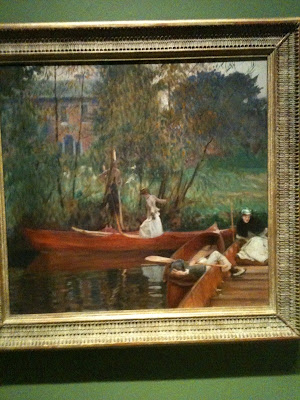White Spots Before Your Eyes
John Singer Sargent, (American, sort of, 1856 1925) A Boating Party, oil, 1889
Here are three great oils I saw this fall in the RISD Art Museum in Providence, RI when I was driving home from my last residency in Edward Hopper's studio on Cape Cod. All three were painted between 1898-1900.
Paintings teach us about new ways of seeing. In the Sargent above, squint your eyes at the picture and see how its surface is mostly an overall grey-green tone. Popping out of that middle tone are a handful of bright white spots in the boating party's clothes. Not quite as dramatic are the small off-white spots of the sky.
Like someone hopping across a stream by stepping on a few exposed stones, Sargent positions his spots of white to create a distinctive rhythm. Imagine how the painting would collapse if the artist had allowed a lot more highlights to creep into his picture. It's a radical painting in that way.
The next year Winslow Homer turned out this stormy ocean scene. Again like the Sargent, it's mostly a middle grey painting, though the whites and off whites now claim much more territory. Squinting at the canvas's overall design, one sees Homer creating a giant checkerboard pattern over the water's surface. The waves in front lean to the left, those in the background lean the other way.
Here's a little design idea Homer uses that's just great. At the left in the foreground, a wall of white spray shoots upwards. Trace your eye along the two right-most points on that vertical spray of water. They connect along an imaginary diagonal line that is exactly at a right angle to the diagonal lines running through the foreground white water.
Mirroring this in the distance, the masts of the ship point upwards along a diagonal of their own, again exactly at a right angle to the wave lifting the ship's hull. This device of implied 90 degree angles hidden among diagonal forms is unconsciously attractive and reassuring to the human mind. It runs all through the history of art. When it's done well, as Homer does it, it looks completely natural.
John White Alexander (American, 1856-1915) The Blue Bowl, oil, 1898
And finally a year before Homer's seascape, John White Alexander gives us a third alternative with how he handles white against dark. Here the background has grown deeper in tone, and the foreground is almost completely filled by the lovely whites of the woman's gown. It's almost as if she's trying to push all the darks out of the picture. In the upper right hand corner the right-most edge of the woman's sleeve, her hand holding the blue bowel, and her protruding jaw zig-zag against the dark background. It's sharp and powerful in a painting where you'd expect only soft, rustling silks.
All three of these painters found something special in their subject and then found a way to show it to us viewers. They understood the expressive power possible in playing off darks against whites. It's a very good exercise to concentrate your eyes on just light and dark, ignoring everything else. Try to do it a dozen times a day just for fun. Surely these three artists practiced seeing this way a lot.





